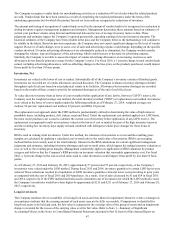Albertsons 2016 Annual Report Download - page 44
Download and view the complete annual report
Please find page 44 of the 2016 Albertsons annual report below. You can navigate through the pages in the report by either clicking on the pages listed below, or by using the keyword search tool below to find specific information within the annual report.
42
• Payments to reduce Capital lease obligations are expected to total approximately $24 in each of fiscal 2017 and fiscal
2018.
• Working capital decreased $116 from $394 as of February 28, 2015 to $278 as of February 27, 2016, excluding the impacts
of the LIFO reserve, primarily due to the classification of $99 of the Secured Term Loan Facility as a current maturity, a
decrease in Cash and cash equivalents and a decrease in Other current assets due to the utilization of the Company's
income tax receivable, offset in part by higher Wholesale inventory from new business.
• Management expects that the Company will be able to fund debt maturities through internally generated funds, borrowings
under the Revolving ABL Credit Facility, additional term loans under the Secured Term Loan Facility (subject to
identifying term loan lenders or other institutional lenders and satisfying certain terms and conditions) or through new debt
issuances.
• Total debt was $2,297 and $2,454 as of February 27, 2016 and February 28, 2015, respectively, net of unamortized debt
refinancing costs and original issue discount, under senior secured credit agreements and debentures.
• No minimum pension contributions were required under ERISA for fiscal 2016. The Company made discretionary pension
contributions and required minimum other postretirement benefit plan contributions totaling $40.
Sources and Uses of Cash
Management expects that the Company will continue to replenish operating assets with internally generated funds and pay
down debt obligations with internally generated funds and new debt issuances or existing credit facilities. A significant
reduction in operating earnings or the incurrence of operating losses could have a negative impact on the Company’s operating
cash flow, which may limit the Company’s ability to pay down its outstanding indebtedness as planned. The Company's credit
facilities are secured by a substantial portion of the Company's total assets and certain subsidiary equity interests.
The Company’s primary sources of liquidity are from internally generated funds and from borrowing capacity under its credit
facilities. The Company will continue to obtain short-term or long-term financing from its credit facilities. Long-term financing
will be maintained through existing and new debt issuances and its credit facilities. The Company’s short-term and long-term
financing abilities are believed to be adequate as a supplement to internally generated cash flows to fund debt obligations and
to fund capital expenditures as opportunities arise. There can be no assurance, however, that the Company’s business will
continue to generate cash flow at current levels or that it will continually have access to credit on acceptable terms. Maturities
of debt issued will depend on management’s views with respect to the relative attractiveness of interest rates at the time of
issuance and other debt maturities.
Primary uses of cash include debt servicing and maturities, capital expenditures, working capital maintenance, contributions to
various benefit plans and income tax payments. The Company’s working capital needs are generally greater during the months
leading up to high sales periods, such as the time period from prior to Thanksgiving through December. The Company typically
finances these working capital needs with cash provided from operating activities and short-term borrowings. Inventories are
managed primarily through demand forecasting and replenishing depleted inventories. Strategic and operational investments in
the Company’s businesses are funded by cash provided from operating activities and on a short-term basis through available
liquidity.
The Company’s continued access to short-term and long-term financing through credit markets depends on numerous factors
including the condition of the credit markets and the Company’s results of operations, cash flows, financial position and credit
ratings.
The Company does not pay dividends, and there is no current intent to pay dividends. The Company is limited in the aggregate
amount of dividends that it may pay under the terms of its Secured Term Loan Facility and its Revolving ABL Credit Facility
and would need to meet certain conditions under these credit facilities before paying a dividend, as described in Note 7—Long-
Term Debt in Part II, Item 8 of this Annual Report on Form 10-K. The payment of future dividends is subject to the discretion
of the Company’s Board of Directors and the requirements of Delaware law, and will depend on a variety of factors that the
Company’s Board of Directors may deem relevant.
























